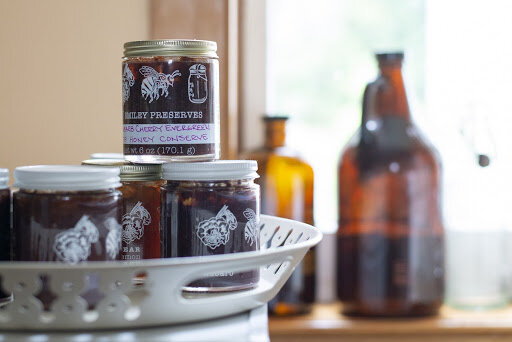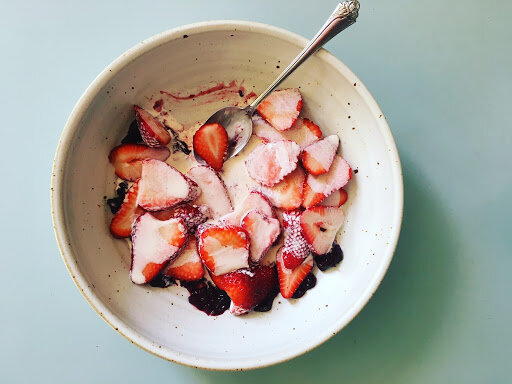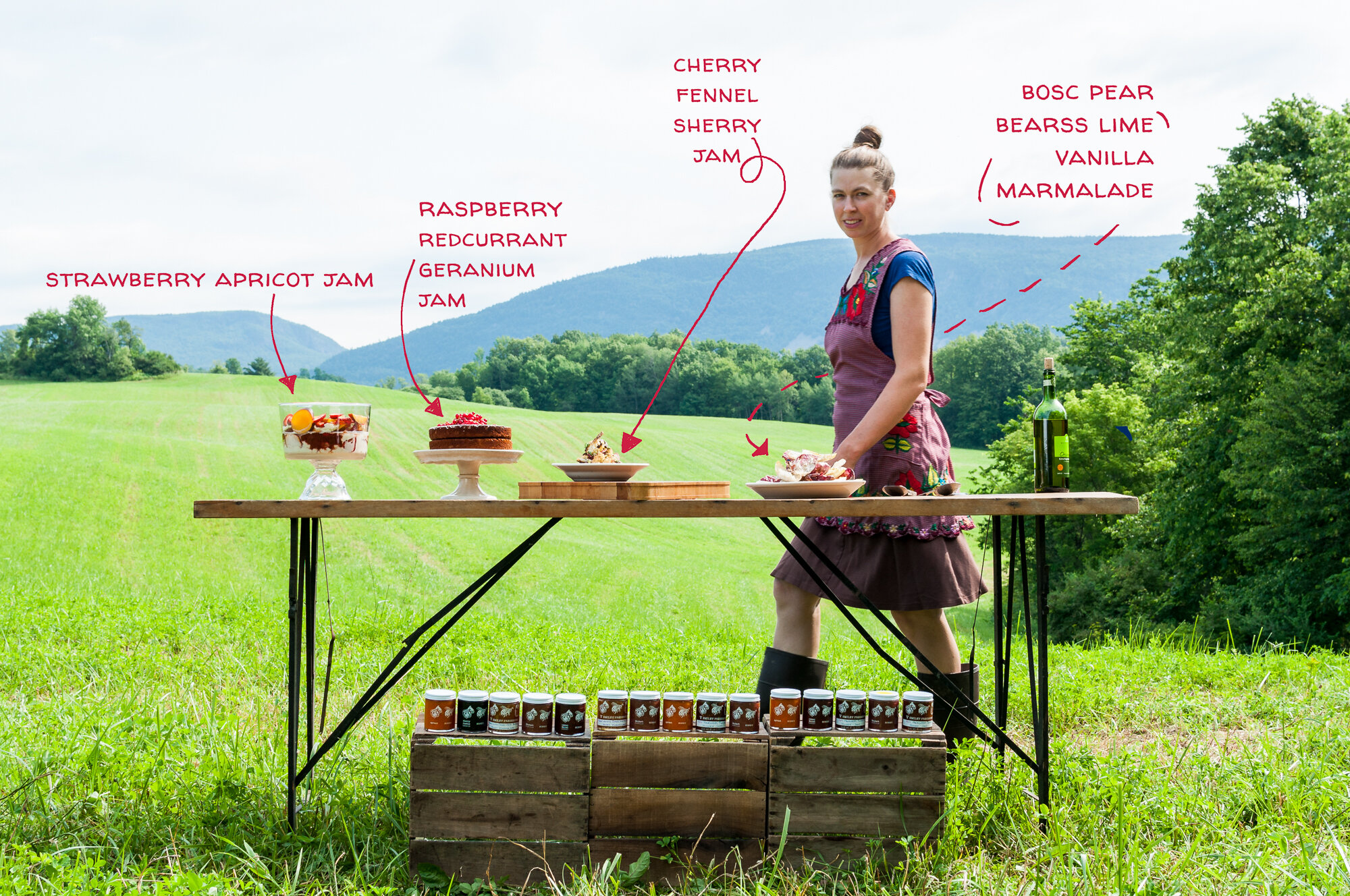
FAQs
Where can I buy V Smiley Preserves?
In the Jam Shop or at one of our Stockists.
A note on shipping: it costs about the same to ship 1 jar as 6-10 jars! We like to bundle or bulk sell jars because then shipping is free! If you have flavor preferences for your Seasonal Bundle purchase you can drop me a line in the "additional notes" section as you check out.
Why honey?
I make jam with honey because I love its taste. Honey is under-represented in preserves. In cookbooks, we read that honey disrupts jam’s clarity of flavor or that honey is a flavor usable like a spice. Here’s the thing. Sugar has a taste too, but it’s a taste we’re very used to and tend not notice as a flavor anymore. Honey is a powerful preservative and sweetener that comes from near-by and is intrinsically linked to the fruit-growing process. Conceptually, I like that as a pollinator the honeybee provides everything we need to make fruit preserves.
What is the shelf life of the preserves?
The contents of sealed, unopened jars last indefinitely, but I don’t recommend letting the jars collect too much dust on your shelves! Once you open a jam, butter or conserve keep any leftovers refrigerated. Because these three preserve types are low in sugar (honey) they should be consumed 4-6 weeks after being opened. Citrus marmalade will last up to 6 months refrigerated after opening, but again, for optimum flavor, I recommend eating them within 3 months of being opened.



Do the jams, butters and marmalades actually set if you don’t use sugar or added pectin?
I produce a range of textures from soft set to firm. All the preserves reach a spreadable consistency and maintain a bright fruit flavor.
Where do you buy your fruit?
V Smiley Preserves are farm and season driven. Making jam is about capturing beautiful fruit and its sibling, honey. Currants, elderberries, apples, rhubarb, gooseberries, raspberries, tomatoes and many aromatics come from the Smiley family farm--affectionately called Lil To Do Farm--in New Haven Vermont. We also use fruit from Omar Fugaro in Middlebury who grows using organic methods though he is not certified organic. The citrus of the marmalades is always certified organic. 75% of the stone fruit comes from New York State's Hudson River Valley orchards, only a couple hours away! The back up stone fruit is certified organic. Scott Farm in Dummerston supplies pomme fruits.
Why is your jam so expensive?
The first time I saw the prices for artisan jams I was flabbergasted. Why so much? The jam is made in tiny batches. One pot of jam produces 6-10 jars. Jam is time intensive! The preparation for that pot of jam can take up to 3 days. This process develops the complete character of the jam. We use exceptional produce. See the above paragraph on where the fruit comes from. One jar of preserves contains about one pound of fruit. The honey comes Champlain Valley Bees and Queens in New Haven Vermont. Kirk Webster who runs this beekeeping operation is known for his natural beekeeping, which means these bees are never sprayed with pesticides or miticides. It is a very special product. The honey I use is 4-5 times the cost of sugar. Other jam-makers compare the price point of their product to wine and artisan cheeses. I think it’s a compelling comparison. My goal is to make preserves as cherished and valuable as a bottle of wine or wedge of local cheese.



How do I use this stuff?
Dessert is served. Jam should taste so good it stands on its own. As a kid I couldn’t believe that my sister made jam and gave it away as Christmas presents. “Really?” I questioned, “jam is a present?” I thought jam was just for toast and peanut butter sandwiches. She explained that she liked to finish her dinner with a couple spoons of preserves. And now, twenty years later, who likes to finish dinner with a spoon of jam? That’s right, me. Those after dinner bites are part of quality control for the jams I make, but I also use jam in my everyday cooking and eating. Jam is a co-conspirator in my kitchen like fine vinegars or oils that add complexity and last minute zazz to food. Here are some general places for jam to become your co-conspirator.
Jam is the baker’s friend. Use it in place of frosting, cake, cookie, and tart filling. Swirl jam into store-bought or homemade ice cream. Make a Fruit Fool with Jam when you don’t have fresh fruit on hand.
Fruit, Honey and Meat, together since antiquity. Braise with marmalade. Stir preserves into your pan juices for an instant, bright sauce.
Cheese and Preserves. This is a traditional pairing, but it’s fun because there are endless combinations to discover and so many artisan cheeses to savor. You never have to buy “Fruit on the Bottom” yogurt again because you make your own with V Smiley Preserves and your favorite yogurt.·
Sandwich spread. Double the tomato on your BLT with Tomato Jam.
Vinaigrettes. Play on the old Raspberry Vinaigrette recipe using preserves.
British and Indian cookbooks illustrate the tradition of preserves in everyday eating and how to incorporate fruit into the savory realm. Some of my favorites include Nigel Slater’s Ripe, Pam Corbin’s River Cottage Cake Handbook, and The Art of Indian Vegetarian Cooking by Yamuna Devi.
Make your toast a ritual.
I want to make my own jam. What books do you recommend?
There are so many books about preserving fruit. I can only pass along the titles I own and treasure. I can’t speak to what’s the best because I haven’t come close to reading all the jam books out there. There is one exception. Rachel Saunder’s Blue Chair Jam Cookbook. This is a definitive text on the art of preserves. If you want to know how to make beautiful, texturally complex jam with tremendous nuance of flavor then buy this book. The Blue Chair Jam Cookbook is the subtlest textbook and discovering it made my honey preserves possible. I also love Pam Corbin’s River Cottage Preserves Handbook, Kevin West’s Saving the Season, Helen Witty’s Fancy Pantry, Barbara Abdeni Massad’s Mouneh, and the book called Preserving Food Without Freezing or Canning.For instructions for preserving with honey you have to go all the way back to the 1970’s and Susan Geipkopf’s Putting It Up With Honey. I post jam recipes on Stovetopletters (the V Smiley Preserves Journal) from time to time. We really need a contemporary book about preserving with honey. Maybe someday I can write that cookbook!

